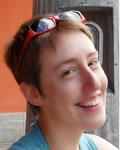2008, 2013
Megan R. Luke
- Assistant Professor
- University of Southern California

Abstract
This is the first study to examine the career of German avant-garde artist Kurt Schwitters (1887-1948) from the vantage of his late work. A master of collage and pioneer of concrete poetry, Schwitters pursued an aesthetic sustained by unfettered international collaboration and a manic mass culture, perversely resisting narratives of developmental inevitability and demanding an opening of the artwork to the entire beholding body. With the collapse of the Weimar Republic and his isolation in exile, Schwitters initiated a sculptural practice and a cache of experimental photographic work that remains virtually unknown, which intensified his ongoing experiments with the intersubjective, performative conditions of perception and the recurrent, mnemonic survival of form.
Abstract
Although scholars across the humanities rely on photographs of art and archaeological objects to construct historical and aesthetic meaning, there remains little consensus today regarding the uses and values of these images for the acquisition and dissemination of knowledge. This collaboration addresses a pressing need for a history and theory of the imaging technologies that scholars use to contemplate and interpret objects. Focusing on the spatial and tactile medium of sculpture, long associated as a medium of embodiment, the collaborators explore how photographic reproductions direct our access to material things and shape our experience of space. Not unbiased copies, these images rather supply the objects they record with a particular setting and a point of view. This project will result in a co-authored book, surveying theories of facsimiles, reproductive technologies, and the limits of perception developed in Europe and America from 1800 to the present, based on research in photographic archives, photo-study collections, and collections of pre-photographic reproductive techniques such as plaster casts and bronzes. Underscoring photography as vital to the global exchange of art objects and cultural artifacts, the collaborators aim to shed new light on its centrality for the writing of art history. This book builds on work the collaborators have completed individually on modern sculptors’ photographs. In recent years, the authors have also collaborated by co-organizing a symposium jointly sponsored by the Clark Art Institute and the Getty Research Institute that brings together leading international scholars across disciplines to address the photographic mediation of sculpture. This symposium and now this co-authored book are conceived at a moment when knowledge circulates through digital images and the Internet to an unprecedented degree. The collaborators look to the interrelated histories of art, mass media, and visual culture to demonstrate how various methods of image production and transmission condition pedagogy and research in ways that vitally direct the future of humanistic inquiry. Award period: July 1, 2013 – June 30, 2015

